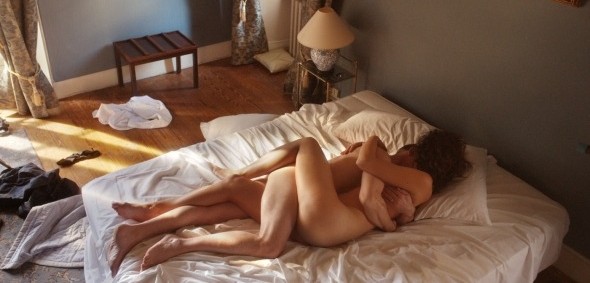“Film your murders like love scenes, and your love scenes like murders” – Alfred Hitchcock
Sex, murder, intrigue. These are the fundamentals that underpin the dramatic framework of Mathieu Amalric’s slender, suspenseful The Blue Room (La chambre bleue). They are fundamentals treated with a steady hand by the French actor-director, showcasing his confident style and economy of expression. Economy, however, comes at the risk of impoverishment, gambling depth and richness for style and concision. In a film that largely depends on the audience’s psychological identification with its characters, it’s a bargain that doesn’t entirely pay off.
Adapted from Georges Simenon’s 1964 novella of the same name, The Blue Room takes us into the world of Julien (Amalric), who meets his mistress, Esther (Stéphanie Cléau, Amalric’s real-life wife and co-writer on the film) in a hotel room on Thursday afternoons. The opening shots show the room vacated, in static, clinical, detail shots that wouldn’t be out of place in a forensic investigation.1 A wooden fireplace, a vase on a desk, a recently vacated bed. The sterility of these images forms a conspicuous clash with the accompanying sounds of lovers’ throes, removing them from any kind of concrete reality and into the realm of memory and imaginative association.
It’s a disconnect characteristic of the film’s ambiguous, non-linear approach to narrative. Focus switches between flashbacks of the affair, scenes of Julien’s guilt-sullied home life with his wife Delphine (Léa Drucker) and daughter, and a police investigation into Julien and Esther. Using sound, these different temporalities blend into each other, with Julien often seen to be consumed in past recollections, sitting and staring while snippets of his conversations with police or dalliances with Ester play over in his mind. The audience is kept in the dark about the precise nature of the investigation until near the end, and it never becomes entirely clear who’s done what, to whom, or why.
Initially, this mystery is intriguing. Amalric imbues Julien with a troubled distance, his characteristic wide-eyed stare looking out while remaining inward-focussed. Cléau is excellent as laid-open and unpredictable Esther, likewise Drucker as the undesired, brave-faced Delphine. There is beauty, too in its 4:3 cinematography, each shot meticulously framed and accompanied by quick-fire editing skilfully orchestrated to show exactly what is necessary. However, the film’s pulse becomes steadily colder as it progresses, teeth remaining on the surface, unable to be sunk in.
Perhaps it’s that its themes of guilt and infidelity, of troubled marriage and crisis of conscience are all too familiar, too well-trodden, or just not dealt with in sufficient depth. Too many blanks are left for the audience to fill. Remaining on the level of a coolly mysterious, ultimately inconclusive investigation into Julien and Ester, The Blue Room doesn’t quite manage to plumb the emotional depths it needs to wholly succeed. However, it certainly satisfies on the level of stylistic and formal beauty, anchored by Amalric’s significant charms.

